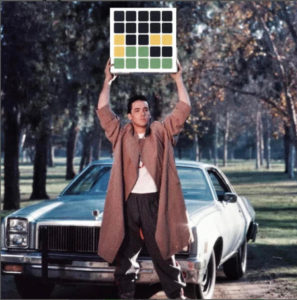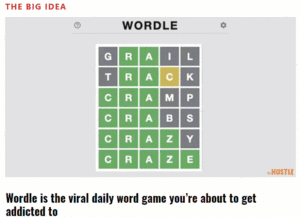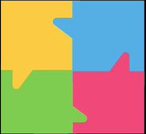Why the Game Mechanics of Wordle Made it Go Viral
What makes games so appealing, and how can you use them to grow your brand?
 This month, Twitter users may have noticed an increase in the number of people posting gray, green, and yellow squares in a grid on their feeds. Memes, art, and even cross-stitching inspired by these matrices have popped up all over the internet on other platforms. The source is the latest pandemic craze: Wordle, a simple online word game that is a good example of using GAME MECHANICS to create social currency (aka “word-of-mouth).
This month, Twitter users may have noticed an increase in the number of people posting gray, green, and yellow squares in a grid on their feeds. Memes, art, and even cross-stitching inspired by these matrices have popped up all over the internet on other platforms. The source is the latest pandemic craze: Wordle, a simple online word game that is a good example of using GAME MECHANICS to create social currency (aka “word-of-mouth).
What makes games so appealing, and why should you incorporate game mechanics into your brand?

Wordle, which reportedly hit 2 million users in less than three months, became so popular so fast that the New York Times scooped it up for an undisclosed price in the low-seven figures last month.
While it is undeniably fun to play games, they are also designed with the human brain in mind. Every time you roll a winning combination with dice, complete a new game quest, or progress in a Candy Crush mobile game, your brain’s reward center lights up like a neon sign.
So why is the latest Wordle crazy so unique and went viral? Because playing it makes us look good.
Wordle game developer Josh Wardle thinks a key reason his game is so popular is that it’s simple and accessible, yet also challenging. “Even though I play it every day, I still feel a sense of accomplishment when I do it: it makes me feel smart, and people like that.”
When it comes to marketing, it is even more than that. Using gamification allows companies to influence, entertain and engage customers in specific activities for the sake of achieving goals at the same time.
“When it comes down to it, this is a big part of what learning is all about: Do something well → your brain gets a reward → you want to do it again!” – The Science behind Gamification
By nature humans are reward-based, and scoring systems, levels, and rankings are systems that allow us to see how well we’re doing in comparison to others. Using gamification tactics to promote a product organically fosters a competitive spirit in your customer, motivating them to try and outperform others. This translates into a form of social currency when used to advance awareness of your brand.
CASE STUDY: Starbucks
For example, businesses have apps that “gamify” the experience of being a customer, but Starbucks is considered one of the best.
If it weren’t for its star system, or the regular sweepstakes and games it uses, Starbucks’ drink recommendations (and store scheduling), it wouldn’t be nearly as effective.
For example, the Starbucks Earth Month Game last April allowed customers who made purchases to participate in a game called Play & Plant. As customers earn points and progress through the levels, they can select the locations where Starbucks will plant trees. Purchases and other “activities” provide upgrades that allow people to advance further in the game. The transition from gamification to a full-fledged game is complete with the added halo effect of customer satisfaction by contributing to social good.
Despite knowing that personal data is being used to improve their sales, it’s all a well-oiled machine that keeps people coming back for more Starbucks. Notifications of when a “Double Star Day” is approaching encourages customers to set aside additional time in their schedule to participate. Starbucks ’ gamification tactics aren’t just a way to make using an app or program more fun; it also “positively impacts engagement” and can “enhance related outcomes,” according to studies.
SOCIAL CURRENCY AND WHY THINGS CATCH ON
As British psychologist Lee Chambers explained to Business Insider, what makes Wordle so appealing is that it stimulates both the language and logic parts of our brains. In the same way that all games make us feel good, this one leads to a release of dopamine, a hormone that allows us to feel pleasure and satisfaction.
This is particularly useful in business because, “Game Mechanics help create social currency because it can give a positive impression to others in our group whose opinions we value,’ says Jonah Berger in his book, Contagious: Why Things Catch On. This is most important for “word-of-mouth growth because when people share their achievements, they also ‘talk about the brands or domains where they achieved them.’”
As a marketer, whether you’re creating a new user recruitment system to lure new hires or simply looking to use gaming mechanics to increase customer engagement, gamification has numerous applications to help make your content go viral.
Wordle, promoting game mechanics using business videos can be a powerful tool for increasing social engagement keep your users coming back again and again with social currency and what your business and do with it.
THE BUSINESS OF GAMIFICATION
Gamification is not the only game in town, but it can certainly be a powerful tool for increasing social engagement and keep your users coming back again and again.
Consider adding game the game-like features used in Gamify’s 7 examples from Headspace, KFC, Under Armour, M&Ms, Starbucks, Nike, & Duolingo to transform your own loyalty programs, learning and more to help turn your business into something much greater.
